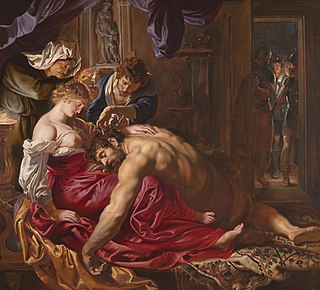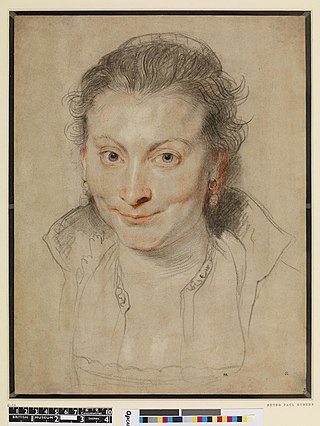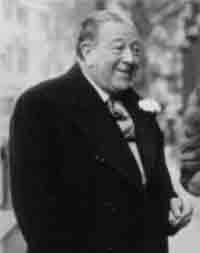Related Research Articles

Jan Brueghelthe Elder was a Flemish painter and draughtsman. He was the son of the eminent Flemish Renaissance painter Pieter Bruegel the Elder. A close friend and frequent collaborator with Peter Paul Rubens, the two artists were the leading Flemish painters in the first three decades of the 17th century.

Jean-Antoine Watteau was a French painter and draughtsman whose brief career spurred the revival of interest in colour and movement, as seen in the tradition of Correggio and Rubens. He revitalized the waning Baroque style, shifting it to the less severe, more naturalistic, less formally classical, Rococo. Watteau is credited with inventing the genre of fêtes galantes, scenes of bucolic and idyllic charm, suffused with a theatrical air. Some of his best known subjects were drawn from the world of Italian comedy and ballet.

Samson and Delilah is a painting long attributed to the Flemish Baroque painter Peter Paul Rubens (1577–1640) and displayed in the National Gallery. It dates from about 1609 to 1610.

The Guild of Romanists or Confrérie van romanisten was a society which was active in Antwerp from the late 16th to the late 18th century. Its membership was made up of notables and artists from Antwerp who had visited Rome. It offered artists access to the networks of Antwerp's urban elites.

Jan van den Hoecke was a Flemish painter, draughtsman and designer of wall tapestries. He was one of the principal assistants in Rubens' studio in the 1630s. He later traveled to Italy where he resided for a decade in Rome. He subsequently worked as a court painter in Vienna and Brussels. Jan van den Hoecke was a versatile artist who created portraits as well as history and allegorical paintings.

Flemish Baroque painting was a style of painting in the Southern Netherlands during Spanish control in the 16th and 17th centuries. The period roughly begins when the Dutch Republic was split from the Habsburg Spain regions to the south with the Spanish recapturing of Antwerp in 1585 and goes until about 1700, when Spanish Habsburg authority ended with the death of King Charles II. Antwerp, home to the prominent artists Peter Paul Rubens, Anthony van Dyck, and Jacob Jordaens, was the artistic nexus, while other notable cities include Brussels and Ghent.

Jan Boeckhorst or Johann Bockhorst was a German-born Flemish Baroque painter and draughtsman. He was a versatile artist who produced history paintings, genre scenes and portraits in a style influenced by the trio of leading Baroque painters in Antwerp Peter Paul Rubens, Anthony van Dyck and Jacob Jordaens. Boeckhorst also worked as a designer of cartoons for tapestries.

Cornelis Schut was a Flemish painter, draughtsman, engraver and tapestry designer who specialized in religious and mythological scenes. Presumed to have trained under Rubens, he treated Counter-Reformation subjects in a High-Baroque style. After a stay in Italy, he worked mainly in Antwerp where he was one of the leading history painters in the first half of the 17th century.

Sir Peter Paul Rubens was a Flemish artist and diplomat from the Duchy of Brabant in the Southern Netherlands. He is considered the most influential artist of the Flemish Baroque tradition. Rubens's highly charged compositions reference erudite aspects of classical and Christian history. His unique and immensely popular Baroque style emphasized movement, colour, and sensuality, which followed the immediate, dramatic artistic style promoted in the Counter-Reformation. Rubens was a painter producing altarpieces, portraits, landscapes, and history paintings of mythological and allegorical subjects. He was also a prolific designer of cartoons for the Flemish tapestry workshops and of frontispieces for the publishers in Antwerp.

Alexander Adriaenssen was a Flemish Baroque painter, particularly known for his still-lifes of fish and game pieces. He also painted banquet pieces with food and flower still lifes.

Isabella Brant,a portrait drawing, was executed in Antwerp around 1621, by Flemish artist and diplomat, Peter Paul Rubens (1577–1640). Brant (1591–1626) was Rubens' first wife and modelled for some of his portraits until her untimely death in 1626. The portrait is drawn in black and red chalk with white heightening on brown wash paper.

The Torre de la Parada is a former hunting lodge that was located in present-day Monte de El Pardo in Fuencarral-El Pardo, near the Royal Palace of El Pardo, some way outside Madrid in the Sierra de Guadarrama. It was mostly destroyed by fire when taken in 1714 by Austrian troops in the War of Spanish Succession, though the ruins remain.
Fritz Grossmann, art historian. Born 26 June 1902 in Stanislau,, now Ivano-Frankivsk in the Ukraine, died 16 November 1984, Croydon, London) was an Austrian-British art historian.

Count Antoine Seilern was an Anglo-Austrian art collector and art historian. He was considered, along with Sir Denis Mahon, to be one of a handful of important collectors who was also a respected scholar. The bulk of his collection was bequeathed anonymously to the Courtauld Institute of Art. Known as the "Princes Gate bequest", most of it is on display at the Courtauld Gallery in London.

Marinus Robyn van der Goes or Marinus van der Goes was a Flemish engraver. He was active as a reproductive engraver after the works of Flemish and Dutch designers.

Portrait of a Commander or A Commander Being Dressed for Battle is a portrait of an unknown man in plate armour, by Peter Paul Rubens. In July 2010 it was sold for £9 million by Christie's after Sotheby's turned it down, suspecting its authenticity as a Rubens. In December 2011, the portrait was placed on loan with the Metropolitan Museum of Art in New York.

Hercules's Dog Discovers Purple Dye or The Discovery of Purple by Hercules's Dog is an oil painting by Flemish artist Peter Paul Rubens painted circa 1636, towards the end of his career. It depicts the mythical discovery of Tyrian purple by Hercules and his dog, and was one of dozens of oil on panel sketches made by Rubens for the decoration of the Torre de la Parada in Spain. A completed painting based on Rubens's sketch was made by Theodoor van Thulden in 1636-8, and is now held by the Prado Museum.

The Vision of the Blessed Hermann Joseph or The Mystical Engagement of the Blessed Hermann Joseph to the Virgin Mary is a 1629-1630 painting by the Flemish Baroque painter Anthony van Dyck.
Paul Raison is a leading world specialist in the field of Old Master paintings. He was for many years a Chairman of the auction house Christie's.

Visitation is a 1610s oil painting by the Flemish Baroque artist Peter Paul Rubens. It is now in the Musée des Beaux-Arts of Strasbourg, France. Its inventory number is 198.
References
- ↑ "Staff". Rubenianum.
- ↑ Schwartz, Gary (15 January 2005). "How Sterre came home". Gary Schwartz Art Historian.
- ↑ Elizabeth McGrath (2012). "Rubens in London" (PDF). The Rubenianum Quarterly (1): 3–4.
- ↑ Sorenson, Lee. "Martin, Gregory". Dictionary of Art Historians.
- ↑ 'Martin, Gregory', in Bazin, Germain, ed. Histoire de l'histoire de l'art, de Vasari à nos jours. Paris: Albin Michel, 1986 p. 515